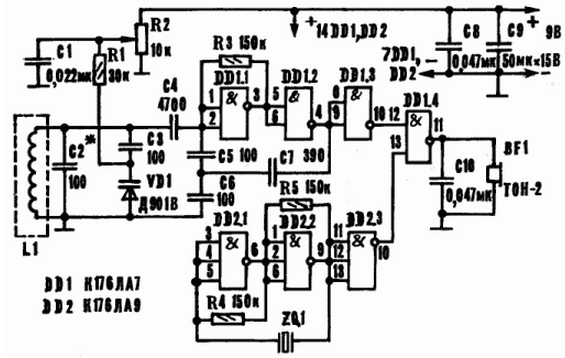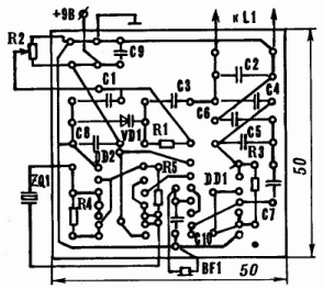Among Amateur radio structures of particular interest are the development, help to detect buried metal objects. Especially if the latter is small in magnitude, lie at a considerable depth, and are to the same neuromagnetism.
Solid electrical circuits of such devices, called by analogy with known military research metal detectors, and descriptions perfectly healthy many designs published in various technical journals. But they are designed often prepared, seasoned DIY experts knows, having a good material base, scarce details.
But our proposed design is quite able to repeat-to make even rookie. The more that the parts needed (including a crystal oscillator, 1 MHz) to purchase will be quite capable. Well, the sensitivity of the collected the metal detector... it can be judged at least by the fact that using the proposed device is easy is sought, for example, copper coin diameter 20 mm and thickness of 1.5 mm at a depth of 0.9 m.

Fig. 1. The electrical circuit high-sensitive improvised metal detector

Fig. 2. A printed circuit Board showing the location of the radioactive elements
The principle of operation is based on the comparison of the two frequencies. One reference, and the other is changing. Moreover, the deviations depend on her appearance in the field a highly sensitive search coil metal objects. Modern metal detectors that can reasonably be attributed and considered design, the reference oscillator operates at a frequency of, for the whole order different from the one that arises in the field of the search coil. In our case the reference oscillator (see circuit diagram) is implemented in two logic elements 3I-NOT an integrated circuit DD2. The frequency of its stable and is determined by the quartz resonator ZQ1 (1 MHz). The same generator with changing modulation performed on the first two elements of IP DD1. Vibrating the contour formed by the search coil L1, capacitors C2 and C3 as well the varicap VD1. And to tune to a frequency of 100 kHz is used, the potentiometer R2, specify the required voltage to the varicap VD1.
As buffer amplifiers are used logic elements DD1.3 and DD2.3, the mixer running on DD1.4. The indicator is a high-impedance a Cup BF1. A capacitor C10 is used as a shunt for high-frequency component from the mixer.
The configuration of the PCB is shown in the corresponding illustration. And the scheme the location of the radioactive elements on the side opposite to the printed conductors, Dana here is a different color.
The metal detector is powered by a DC source voltage V. 9 As well how high stabilization is not essential here, used battery type "Krone". As a filter successfully employed capacitors C8 and C9.
The search coil requires great precision and attention during manufacture. Wrap it in vinyl tube with an outer diameter of 15 mm and an inner - 10 mm, bent in the shape of a circle with a diameter of 200 mm. the Coil has 100 turns of wire sew-0,27. When the winding is completed, she wraps aluminum foil to create an electrostatic screen (reducing the influence of the capacity between coil and earth). It is important to prevent electrical contact between the wire winding and sharp edges of the foil. In particular, will help here "obviuse obliquely". And to protect the aluminum coating from mechanical damage the coil further entwine insulation binding tape.
The diameter of the coil may be different. But the smaller, the sensitivity the entire device becomes higher, but the size of the hidden metal items shrinking. If you increase the diameter of the coil effect is observed return.
Working with a metal detector as follows. Placing the search coil in the vicinity of the surface of the earth, set up the generator potentiometer R2. And so, in a telephone earpiece sound is not auditioned. When moving the coil over the surface of the earth (close to last) and searches for the coveted place on the advent of sound in the telephone earpiece.
If you use the above devices to find hidden in the ground objects of archaeological and national cultural value, requires prior permission from the relevant authorities.
Author: N. Kochetov






